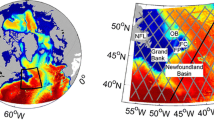Abstract
During 1999–2000, 13 bottom mounted acoustic Doppler current profilers (ADCPs) and 12 wave/tide gauges were deployed along two lines across the Korea/Tsushima Strait, providing long-term measurements of currents and bottom pressure. Tidally analyzed velocity and pressure data from the moorings are used in conjunction with other moored ADCPs, coastal tide gauge measurements, and altimeter measurements in a linear barotropic data assimilation model. The model fits the vertically averaged data to the linear shallow water equations in a least-squares sense by only adjusting the incoming gravity waves along the boundaries. Model predictions are made for the O1, P1, K1, μ2, N2, M2, S2, and K2 tides. An extensive analysis of the accuracy of the M2 surface-height predictions suggests that for broad regions near the mooring lines and in the Jeju Strait the amplitude prediction errors are less than 0.5 cm. Elsewhere, the analysis suggests that errors range from 1 to 4 cm with the exception of small regions where the tides are not well determined by the dataset. The errors in the model predictions are primarily caused by bias error in the model’s physics, numerics, and/or parameterization as opposed to random errors in the observational data. In the model predictions, the highest ranges in sea level height occur for tidal constituents M2, S2, K1, O1, and N2, with the highest magnitudes of tidal velocities occurring for M2, K1, S2, and O1. The tides exhibit a complex structure in which diurnal constituents have higher currents relative to their sea level height ranges than semi-diurnal constituents.
Similar content being viewed by others
References
Choi, B. H. (1999): Digital Atlas for Neighboring Seas of Korean Peninsula. Laboratory for Coastal and Ocean Dynamics Studies, Sung Kyun Kwan University, CD-ROM.
Choi, B. H., D. H. Kim and Y. Fang (1989): Tides in the East Asian Seas from a fine-resolution global ocean tidal model. MTS Journal, 33, 36–44.
Dowd, M. and K. R. Thompson (1996): Extraction of tidal streams from a ship-borne acoustic Doppler current profiler using a statistical-dynamical model. J. Geophys. Res., 101(C4), 8943–8956.
Fang, G. and J. Yang (1988): Modeling and prediction of tidal currents in the Korea Strait. Prog. Oceanogr., 21, 307–318.
Foreman, M. G. G. (1977): Manual for tidal heights analysis and prediction. Pacific Marine Science Report, 77-10, Institute of Ocean Science, Patricia Bay, Sidney, B.C., Canada.
Foreman, M. G. G. (1978): Manual for tidal currents analysis and prediction. Pacific Marine Science Report, 78-6, Institute of Ocean Science, Patricia Bay, Sidney, B.C., Canada.
Golub, G. H. and C. F. Van Loan (1996): Matrix Computations: third edition. Johns Hopkins University Press.
Griffin, D. A. and K. R. Thompson (1996): The adjoint method of data assimilation used operationally for shelf circulation. J. Geophys. Res., 101(C2), 3457–3477.
Hallock, Z. R., P. Pistek, J. W. Book, J. L. Miller, L. K. Shay and H. T. Perkins (2003): A description of tides near the Chesapeake Bay entrance using in situ data with an adjoint model. J. Geophys. Res., 108(C3), doi:10.1029/2001JC000820.
Kang, S. K., S.-R. Lee and K.-D. Yum (1991): Tidal computation of the East China Sea, the Yellow Sea, and the East Sea. p. 25–48. In Oceanography of Asian Marginal Seas, ed. by K. Takano, Elsevier.
Kang, S. K., J.-Y. Chung, S.-R. Lee and K.-D. Yum (1995): Seasonal variability of the M2 tide in the seas adjacent to Korea. Cont. Shelf Res., 15(9), 1087–1113.
Kang, Y. Q. (1984): An analytic model of the M2 tide near Cheju Island. The Journal of the Oceanological Society of Korea, 19(1), 18–23.
Kantha, L. H., I. Bang, J.-K. Choi and M.-S. Suk (1996): Shallow water tides in the seas around Korea. The Journal of the Korean Society of Oceanography, 31(3), 123–133.
Lee, S. and K. Kim (1999): Scattering of tidal frequency waves around a cylindrical island. J. Phys. Oceanogr., 29, 436–448.
Lefevre, F., C. Le Provost and F. H. Lyard (2000): How can we improve a global ocean tide model at a regional scale? A test on the Yellow Sea and the East China Sea. J. Geophys. Res., 105(C4), 8707–8725.
Naval Oceanographic Office (1997): Data Base Description for Digital Bathymetric Data Base—Variable Resolution (DBDB-V) Version 1.0, Internal Report, Naval Oceanographic Office, Stennis Space Center, MS, U.S.A.
Odamaki, M. (1989): Tides and tidal currents in the Tusima Strait. J. Oceanogr. Soc. Japan, 45, 65–82.
Ogura, S. (1933): The tides in the Seas adjacent to Japan. Bulletin of Hydrographic Department, 7, Imperial Japanese Navy.
Reid, R. O. and B. R. Bodine (1968): Numerical model for storm surges in Galveston Bay. Journal of the Waterways and Harbors Division, Proceedings of the American Society of Civil Engineers, 94(WW1), 33–57.
Smith, W. H. F. and P. Wessel (1990): Gridding with continuous curvature splines in tension. Geophysics, 55(3), 293–305.
Teague, W. J., P. Pistek, G. A. Jacobs and H. T. Perkins (2000): Evaluation of tides from TOPEX in the Bohai and Yellow Sea. J. Atmos. Ocean. Technol., 17, 679–687.
Teague, W. J., H. T. Perkins, G. A. Jacobs and J. W. Book (2001): Tide observations in the Korea-Tsushima Strait. Cont. Shelf Res., 21, 545–561.
Teague, W. J., H. T. Perkins, G. A. Jacobs, J. W. Book, K.-I. Chang and M.-S. Suk (2002): Low frequency current observations in the Korea/Tsushima Strait. J. Phys. Oceanogr., 32, 1621–1641.
Thacker, W. C. (1987): Three lectures on fitting numerical models to observations. Report GKSS 87/E/65, GKSS Forschungszentrum Geesthacht GmbH, Geesthacht, Germany.
Thompson, K. R., M. Dowd, Y. Lu and B. Smith (2000): Oceanographic data assimilation and regression analysis. Environmetrics, 11, 183–196.
Wessel, P. and W. H. F. Smith (1998): New, improved version of Generic Mapping Tools released. EOS, Trans., A.G.U., 79(47), 579.
Author information
Authors and Affiliations
Corresponding author
Rights and permissions
About this article
Cite this article
Book, J.W., Pistek, P., Perkins, H. et al. Data Assimilation Modeling of the Barotropic Tides in the Korea/Tsushima Strait. J Oceanogr 60, 977–993 (2004). https://doi.org/10.1007/s10872-005-0006-6
Received:
Revised:
Accepted:
Issue Date:
DOI: https://doi.org/10.1007/s10872-005-0006-6




